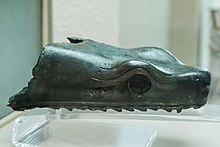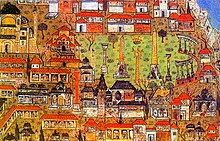Serpent Column
The serpent heads of the 8-metre (26 ft) high column remained intact until the end of the 17th century (one is on display at the nearby Istanbul Archaeology Museums).
Together with its original golden tripod and cauldron (both long missing), it constituted a trophy, or offering reminding of a military victory, dedicated to Apollo at Delphi.
Among the writers who allude to the Column in the ancient literature are Herodotus, Thucydides, pseudo-Demosthenes, Diodorus Siculus, Pausanias the traveller, Cornelius Nepos and Plutarch.
The removal of the column by the Emperor Constantine to his new capital, Constantinople, is described by Edward Gibbon, citing the testimony of the Byzantine historians Zosimus, Eusebius, Socrates, and Sozomenus.
The Greeks under the leadership of Pausanias, Regent of Sparta,[a] drew up on high ground in defensive positions south of the river Asopus and above the plain of Plataea.
After describing the Greek victory at Plataea, in 479 BC, Herodotus recounts the collection of rich spoils, by the Helots, (the Spartan underclass), who had taken part in the battle, and then records the decision of the Greek cities to dedicate an offering to Apollo at Delphi:[1][3] Having brought all the loot together, they set apart a tithe for the god of Delphi.
Thucydides describes[4] the Spartan suspicion that Pausanias was at the point of committing treason and going over to the Persians, citing the Serpentine column affair as evidence.
In a speech, "Against Neaira", the orator recalls the conduct of Pausanias after the defeat of the Persians in the battle of Plataea over the Serpentine column: "Pausanias, King of the Lacedaemonians, caused a diptych to be inscribed on the tripod at Delphi, [which those Greeks, who had fought as allies in the battle of Plataea and in the naval engagement at Salamis had together made from the spoils taken from the Barbarians and had set up in honour of Apollo as a memorial to their bravery], as follows: 'Pausanias, commander-in-chief of the Greeks, when he had destroyed the army of the Medes dedicated this memorial to Phoebus (Apollo)', as if the work and the offering were his alone, and not from the allies together.
[3] Even at the time of Pausanias’ visit, the Sacred Way, leading up to the temple of Apollo, was lined on both sides with monuments, statues and treasuries commemorating important events in Greek History.
[8] Above these loomed the great bronze statue of Apollo, and, on the architrave of the temple, shields commemorating a Greek victory over the Gauls.
[citation needed] Many Ottoman miniatures show the serpent heads were intact in the early decades following the Turkish conquest of the city.
[10] Ahmed Bican, from Gallipoli, gave a short description of the Column in his Dürr-i Meknûn, written around the time of the Fall of Constantinople.
[11] Between fifty and one hundred years after the Turkish conquest of Constantinople, the jaw of one of the three serpent heads was documented missing.
[12] Edward Gibbon recounts a version of this event: The conqueror gazed in satisfaction and wonder on the strange though splendid appearance of the domes and palaces, so dissimilar from the style of Oriental architecture.
Silahdar Findiklili Mehmed Aga relates in Nusretname ("The Book of Victories") that the heads simply fell off on the night of October 20, 1700.
In the aforementioned paragraph Pausanias lists the names on the offering to Zeus at Olympia, which exclude four cities inscribed on the Serpentine column.






